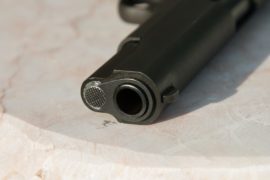
Safety Enforcement for Gunsmiths: The 4 Cardinal Rules
Safety’s first, right? When it comes to best practices, gunsmiths have to go the extra mile compared to everyone else. Not only do they handle firearms daily, but the guns in their hands are often defective, modified from stock, or otherwise irregular. That calls for extra vigilance and precautions to avoid putting holes in the office, the office neighbors, or our own eardrums.
The four rules of safe handling formulated by Jeff Cooper apply, but only as a starting point. Let’s look at them in detail, and what precautions can be taken by practicing gunsmiths.
Rule 1: Never point your firearms at anything you do not wish to destroy.
In an office environment, safe directions are few because walls either present only a slight barrier for projectiles or pose a ricochet risk. In the absence of natural safe directions, they should be created artificially, with sandbags being the simplest method for satisfying both requirements. Ideally, the line of sandbags or rubber-shrouded steel backstops should cover at least a 180 degree arc to allow for safe rotation of guns from one orientation to the other.
In handling guns outside the work bench, keep in mind that they may be loaded and the action in an unstable state, such as a tripped but stuck sear or a bolt with a protruding firing pin. Assume that any firearm handed in may fire at any moment and manage the muzzle direction accordingly. A second direction to mind is the ejection port and any pressure relief openings in the receiver, such as those at the side of Mauser actions. Especially in case of an out-of-battery discharge, both present additional danger to the gunsmith.
In addition to keeping the muzzle direction in check yourself, be aware of the customers’ actions. Not everybody follows the best practices, so gently guiding the guns to safe orientation becomes a part of the gunsmith’s work.
This brings us to the requirement to employ eye and ear protection, and to the advisability of firing any guns being diagnosed or repaired using a fixture and a remote activator. Either bulletproof glass or video will provide a few of the firearms being fired without a direct line of exposure to possible ejecta or fragments in case of a catastrophic malfunction. In many cases, blanks or primed cases without powder can be as diagnostically useful as live ammunition, especially when working out trigger issues.
Rule 2: Always treat a firearm as if it’s loaded.
This really stands for “assume all firearms are loaded unless verified otherwise.” For testing, guns may have to be loaded for live fire, loaded with snap caps for safe feed and cycle testing, or unloaded. Because a repaired or modified gun cannot be assumed to function correctly, extra vigilance is required in ascertaining the chamber and magazine status. Just cycling the bolt to clear the action might produce no results if the extractor is defective or missing. Seeing a dimpled primer doesn’t guarantee that that cartridge in the chamber has been fired either. One of the best helpers in this is a small flashlight for chamber and magazine checks, as well as a borelight that may be shined from either end of the barrel to verify clear.
Rule 3: Keep your finger off the trigger until your sights are on the target and you are ready to fire.
Especially with newly installed or modified triggers, we cannot assume even the slightest lever of consistency. For example, a two-stage trigger may stick in the half-way position and become single stage. Excessive friction in the trigger internals combined with minimal sear engagement can lead to a delayed hammer drop, as observed in Colt SAA clones. Reduced sear engagement may turn a safe four-pound trigger into a hair-trigger set off by vibration. As a corollary to this rule, remember to keep the finger on the trigger after the shot breaks to avoid accidental bump-firing in case of an unusually short reset travel. In general, loading a single round for the initial testing avoids accidental bursts in the event of out-of-spec parts or incorrect adjustment.
Keeping the trigger finger conspicuously out of the trigger guard has social utility as well. While a decocked, unloaded single-action firearm is as safe as it can get, an outside observer might not know it. Keeping the safety protocol consistent not only helps with personal longevity but also avoids alarming customers and casual observers.
Rule 4: Always be certain of your target and what’s beyond it.
This circles us back to having a safe backstop for firearms handled on the workbench and on the way to the range. Chamber flags that prevent bolt or slide closure allow moving firearms safety. For manually operated firearms, opening the action may be sufficient to render a gun inert. With semiautos, an open action isn’t necessarily safe as accidental activation of bolt release lever or button could chamber a round and, on a mid-repair gun, fire it. Some firearms, such as M1 Garand and Mauser HSC, are designed to close the action as soon as a clip or a magazine is inserted, bringing us back to Rule 1.
Familiarity with small arms should not breed complacency or careless handling. The gunsmith faces a considerable cumulative risk of accidents due to the nature of guns brought in, and increased vigilance combined with building safety features into the workspace if the way to mitigate that risk. Handling directions should be prominently visible to the customers as well to reduce the risks at the hand-off stage of the work.
By: Oleg Volk, Firearms Photographer

